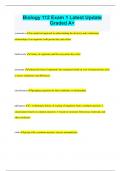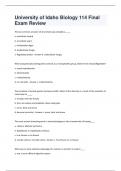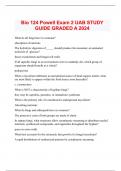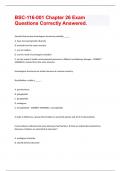Monophyletic group - Study guides, Class notes & Summaries
Looking for the best study guides, study notes and summaries about Monophyletic group? On this page you'll find 261 study documents about Monophyletic group.
Page 4 out of 261 results
Sort by

-
Biology 112 Exam 1 Latest Update Graded A+
- Exam (elaborations) • 6 pages • 2024
-
- $7.99
- + learn more
systematics an analytical approach to understanding the diversity and evolutionary relationships of an organism, both present day and extinct biodiversity variety of organisms and the ecosystems they form taxonomy ordered division of organisms into categories based on a set of characteristics used to assess similarities and differences classification grouping organisms by their similarites or relationships phylogeny 1. evolutionary history of a group of organisms from a common ancestor; 2....

-
University of Idaho Biology 114 Final Exam Review Questions With 100% Correct Answers!!
- Exam (elaborations) • 40 pages • 2024
-
- $7.19
- + learn more
The last common ancestor of all animals was probably a ____. a. unicellular chytrid b. unicellular yeast c. multicellular algae d. multicellular fungus e. flagellated protist - Answer-d. multicellular fungus What synapamorphy distinguishes animals as a monophyletic group, distinct from choanoflagellates? a. sexual reproduction b. heterotrophy c. multicellularity d. no cell walls - Answer-c. multicellularity The evolution of animal species has been prolific. Much of this diversity is a...

-
Bio 117 Exam 2 | Questions & 100% Correct Answers (Verified) | Latest Update | Grade A+
- Exam (elaborations) • 59 pages • 2024
- Available in package deal
-
- $14.99
- + learn more
Bio 117 Exam 2 | Questions & 100% Correct Answers (Verified) | Latest Update | Grade A+ Which of the following is NOT a characteristic of ALL animals? A. Heterotrophic B. Together, they form a monophyletic group. C. Multicellular organisms D. Cells lacking cell walls. E. All animals have true tissues and organs. Correct Answer: All animals have true tissues and organs. Which of the following are characteristics of Phylum Cnidaria? (Select All that Apply) A. Specialized ...

-
Bio 117 exam 2 quiz with 100% correct solutions
- Exam (elaborations) • 49 pages • 2024
- Available in package deal
-
- $13.49
- + learn more
Bio 117 exam 2 quiz with 100% correct solutions Which of the following is NOT a characteristic of ALL animals? A. Heterotrophic B. Together, they form a monophyletic group. C. Multicellular organisms D. Cells lacking cell walls. E. All animals have true tissues and organs. - Correct Answer ️️ -All animals have true tissues and organs. Which of the following are characteristics of Phylum Cnidaria? (Select All that Apply) A. Specialized stinging cells B. True Tissues C. Comp...

-
Bio 117 exam 2 quiz with 100% correct solutions
- Exam (elaborations) • 49 pages • 2024
-
- $13.49
- + learn more
Bio 117 exam 2 quiz with 100% correct solutions Which of the following is NOT a characteristic of ALL animals? A. Heterotrophic B. Together, they form a monophyletic group. C. Multicellular organisms D. Cells lacking cell walls. E. All animals have true tissues and organs. - Correct Answer ️️ -All animals have true tissues and organs. Which of the following are characteristics of Phylum Cnidaria? (Select All that Apply) A. Specialized stinging cells B. True Tissues C. Comp...

-
BIO 117 Exam 2 | Questions & 100% Correct Answers (Verified) | Latest Update | Grade A+
- Exam (elaborations) • 21 pages • 2024
- Available in package deal
-
- $12.49
- + learn more
BIO 117 Exam 2 | Questions & 100% Correct Answers (Verified) | Latest Update | Grade A+ which protists use pseudopodia to feed Correct Answer: amoebae forams which protists have silica-based skeletons Correct Answer: diatoms which protists are our closest relatives Correct Answer: choanoflagellates; opisthokonta what material is NOT used by protists in hard outer coverings Correct Answer: lignin T/F? fungi are a monophyletic group Correct Answer: true 2 T/F? fungi are more clos...

-
Bio 124 Powell Exam 2 UAB STUDY GUIDE GRADED A 2024
- Exam (elaborations) • 32 pages • 2024
-
Available in package deal
-
- $15.49
- + learn more
What do all fungi have in common? absorption of nutrients The hydrolytic digestion of _____ should produce the monomer, an aminated molecule of -glucose? Insect exoskeleton and fungal cell walls If all saprobic fungi in an environment were to suddenly die, which group of organisms should benefit as a whole? prokaryotes When a mycelium infiltrates an unexploited source of dead organic matter, what are most likely to appear within the food source soon thereafter? c. exoenzymes What is NOT ...

-
BIOL 205 Midterm 1 Questions and Correct Answers
- Exam (elaborations) • 9 pages • 2024
-
Available in package deal
-
- $9.99
- + learn more
How did Ernst Mayr summarize Darwin's basic ideas? Mayr proposed that Darwin's theory of natural selection could explain all of evolution, including why genes evolve at the molecular level. On the stubborn question of how species originate, Mayr proposed that when a population of organisms becomes separated from the main group by time or geography, they eventually evolve different traits and can no longer interbreed. Mayr declared that the development of many new species is what leads to evolu...

-
BSC-116-001 Chapter 26 Exam Questions Correctly Answered.
- Exam (elaborations) • 9 pages • 2024
-
Available in package deal
-
- $11.99
- + learn more
BSC-116-001 Chapter 26 Exam Questions Correctly Answered. Animals that possess homologous structures probably _____. A. have increased genetic diversity B. evolved from the same ancestor C. are not related D. are the result of convergent evolution E. are the result of similar environmental pressures in different evolutionary lineages - CORRECT ANSWER B. evolved from the same ancestor Homologous structures are similar because of common ancestry. By definition a clade is _____. ...

-
Bio 180 |110 Quiz Questions Correctly Solved|2024
- Exam (elaborations) • 7 pages • 2024
-
- $8.49
- + learn more
About when did the first limbs evolve in tetrapods (land-dwelling vertebrates)? - ️️-365 million years ago. According to the figure in the text, about how large will the world human population be in 2050 if the current average fertility rate does not change? - ️️10.8 billion. Are sponges monophyletic or paraphyletic? - ️️Paraphyletic. Are the vertebrates monophyletic? - ️️Yes--they all derive from a common ancestor where the cranium and vertebrae evolved. As a principle in lo...

$6.50 for your textbook summary multiplied by 100 fellow students... Do the math: that's a lot of money! Don't be a thief of your own wallet and start uploading yours now. Discover all about earning on Stuvia


